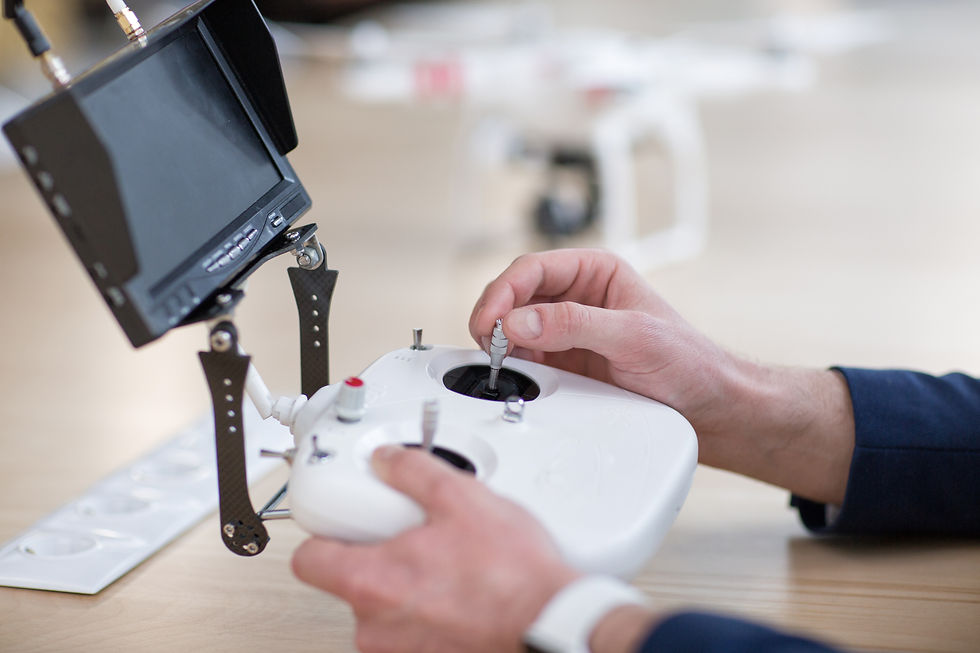Impact of Continuous Drone Innovations in the Utility Industry - AUVSI
- Jose Martin

- May 18, 2024
- 4 min read
Updated: Oct 17
At the AUVSI Conference in San Diego, I had the opportunity to listen to industry leaders on the energy panel, including Andy McCauley, Manager at BGE Exelon; Cynthia Huang, CEO of ACSL INC.; James Pierce, Manager of Robotic Inspection at Ameren; Christine Asaro, Project Advisor in San Diego; and Slade Bridges, Analyst at Southern Company.
The utility industry is rapidly evolving with the integration of drone technology, bringing forth a wave of innovations to enhance operational efficiency, safety, and scalability. The energy panel at the AUVSI Conference highlighted the growing importance of standardization, scalability, and the establishment of dedicated teams for drone operations. The panel also underscored the critical need for internal communication, stakeholder engagement, and continuous innovation to remain at the forefront of technological advancements.
Enhancing Safety with Drone Technology
The safety benefits of drones are particularly evident in operations such as solar farms, wind turbine inspections, gas and oil pipeline sites, and lineman work. Line installers and repairers face dangerous working conditions. By reducing human exposure to high-risk tasks, drones ensure that workers can perform their duties with minimal risk. In 2015, while I was working on a Supplemental Type Certificate (STC) for a helicopter used in lineman work, the inherent dangers of traditional methods became clear. These hazards include to name a few:
Electrical Risks include direct contact, touch voltage, step voltage, transferred voltage, AC induction, lightning, and accidental energization.
Arc flash, open flames, fires, and explosions generate thermal hazards.
Physical Risks include electric shock, arc flash, and broken hardware.
Chemical Hazards include battery acid, asbestos, and transformer oil.
Traditional lineman work exposes both linemen and pilots to these significant risks, sometimes resulting in fatalities (refer to Figures 1 and 2).


Martin Solutions has secured waivers and exemptions to operate drones in high-risk environments. These regulatory approvals allow the company to use drones for tasks that would otherwise require human workers to be exposed to dangerous conditions.
Drone Programs and Pilot Training
Utility companies are setting the bar high with their extensive drone programs. For example, the New York Power Authority (NYPA) has approved the first funding phase for a $37.2 million drone program to enhance inspection capabilities over the next five years. This initiative aims to improve the safety and efficiency of NYPA’s operations, reduce costs, and support New York's clean energy goals.
Drones have rapidly evolved and become essential tools for utility operations. Planning for NYPA's formal drone program began in 2019, with the development of policies and procedures to guide drone use. In 2021, a drone program manager was hired to create a unified program supporting the Authority’s strategic VISION2030 goals.
Now, the program has 100 pilots across the NYPA. The new drone program will enable consistency across NYPA by developing standardized policies and procedures for mission planning and flying. It will also create a data platform for saving and viewing data generated from drone missions.
Internal Innovation and Communication
Innovation within the utility sector is not without its challenges. Significant strides are being made in advocating for and implementing new technologies, though internal battles are often faced to maintain progress. Emphasizing the importance of staying ahead of technological advancements, leaders share experiences and strategies for continuous improvement in infrastructure maintenance.
Effective communication with internal stakeholders is critical for successfully adopting new technologies. By continuously engaging with these stakeholders, utility companies can foster a culture of innovation and ensure smooth transitions when implementing new solutions. Demonstrating the benefits of drone technology and involving teams in the innovation process has proven highly effective.
Safety Inspections and Data Analysis
Drones are invaluable tools for safety inspections and data analysis, particularly in the construction industry. Utilizing safety data to secure buy-in for drone inspections and highlighting the critical role of change management is essential. Involving teams in the process and making them feel invested in the idea enhances acceptance and implementation.
By showcasing successful implementations within the industry, teams are more likely to embrace these innovations.
Operational Efficiency and Cost Savings
Drones have significantly improved operational efficiency and cost savings in utility inspections and maintenance. Projects using drones for tagging lines in waterways have resulted in substantial cost reductions compared to traditional methods. Drones bring advantages to various operations, including line pulling and bridge inspections, reducing reliance on helicopters.
Innovative uses of drones for inspecting lifelines on transmission towers significantly enhance safety. Additionally, drones are being used to inspect cooling towers, creating 3D models that eliminate the need for inspectors to hang off the sides of towers.
Moreover, utility companies are utilizing drones and digital twins to inspect and replace aging infrastructure, demonstrating the technology's capacity to modernize and streamline maintenance processes.
Conclusion
The utility industry's adoption of drone technology is a testament to the power of innovation and collaboration. By prioritizing standardization, scalability, and dedicated teams, and by fostering continuous internal communication and stakeholder engagement, utility companies are enhancing their operations and paving the way for a safer and more efficient future. As these technologies evolve, the industry stands ready to embrace new challenges and opportunities, driving progress and setting new standards for excellence.




Comments